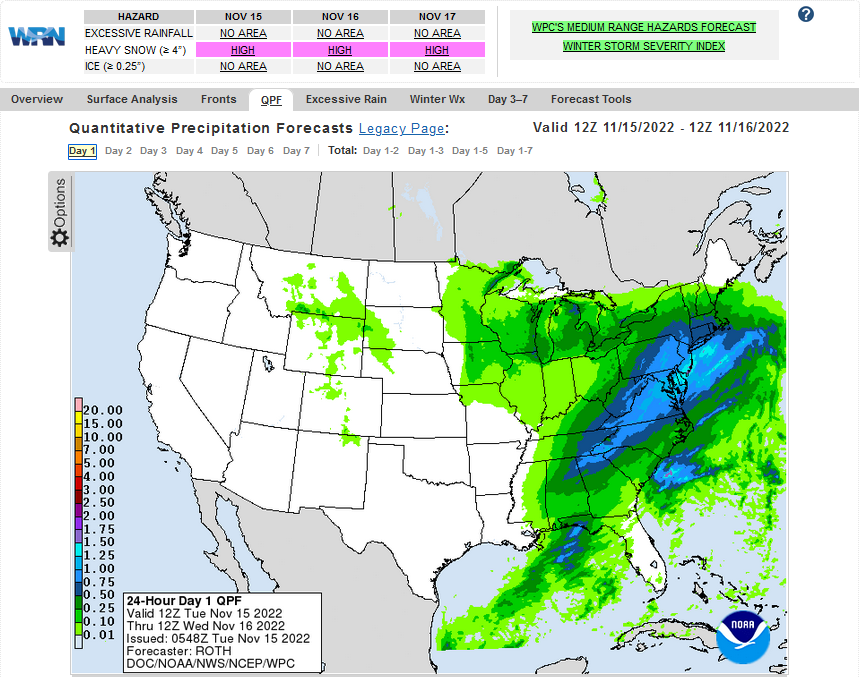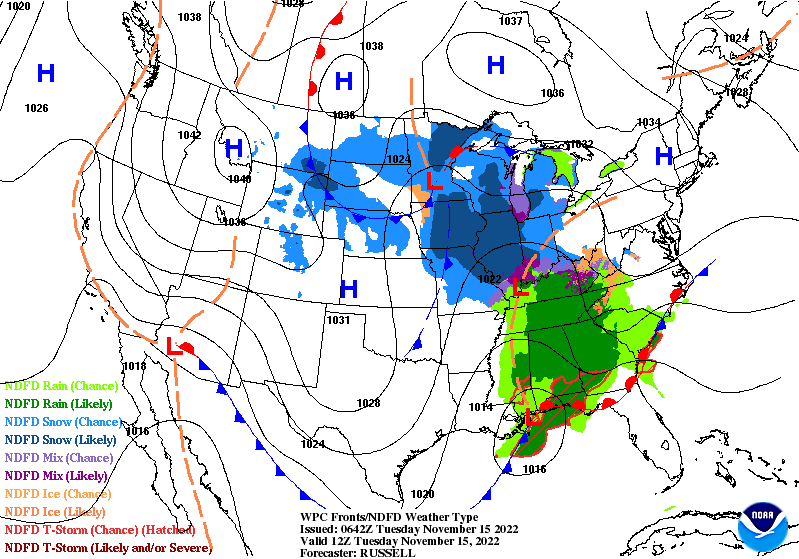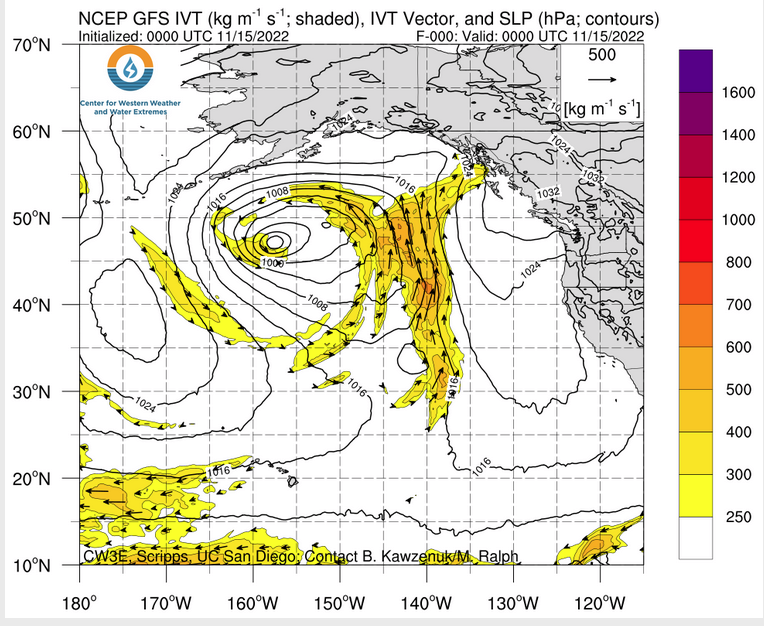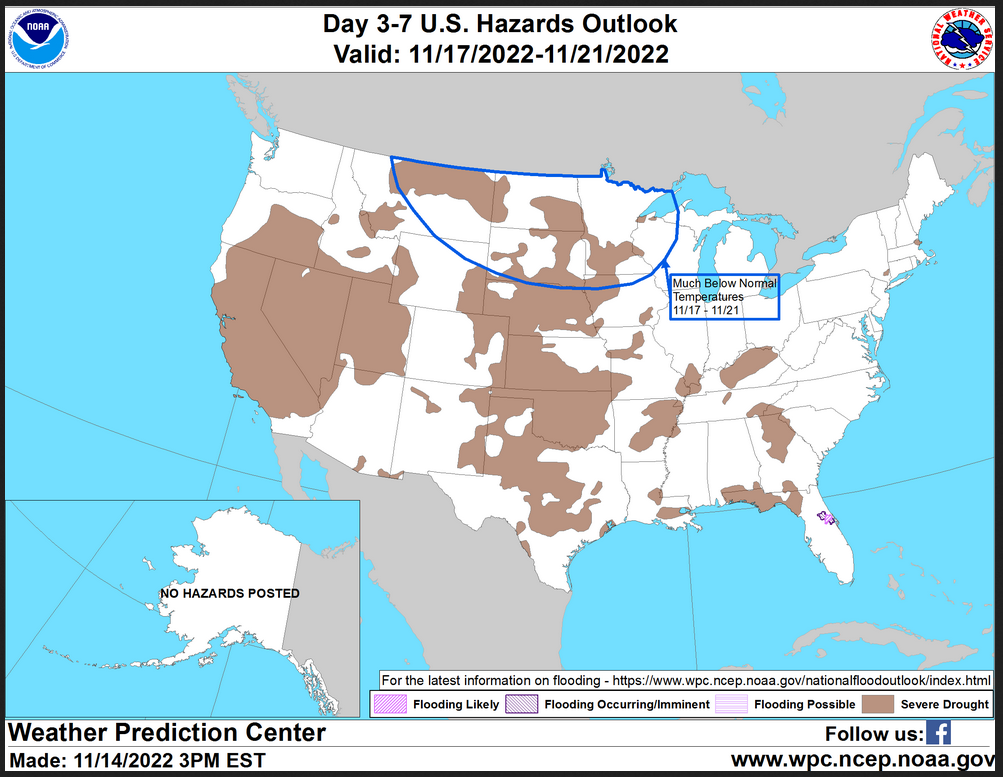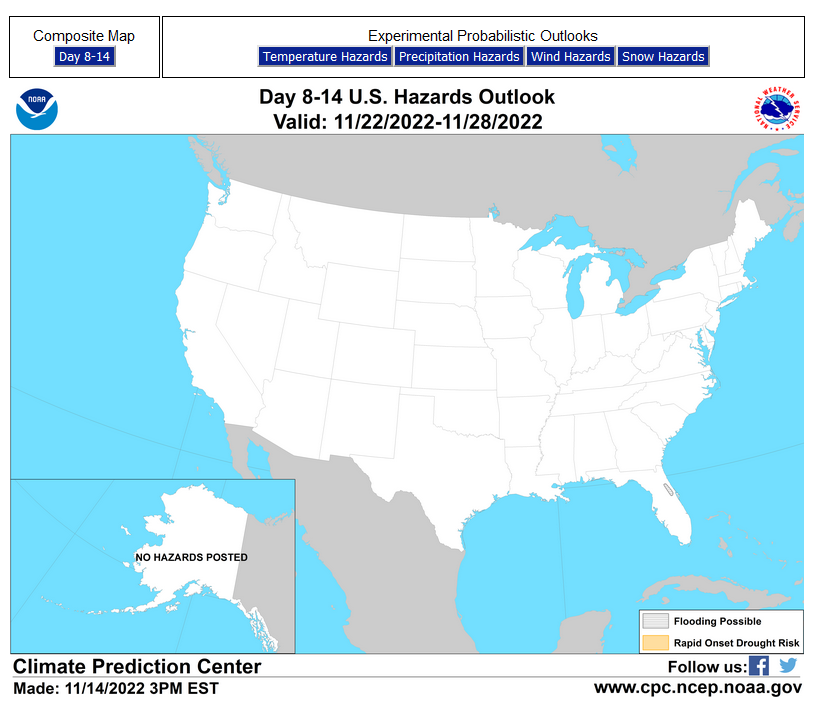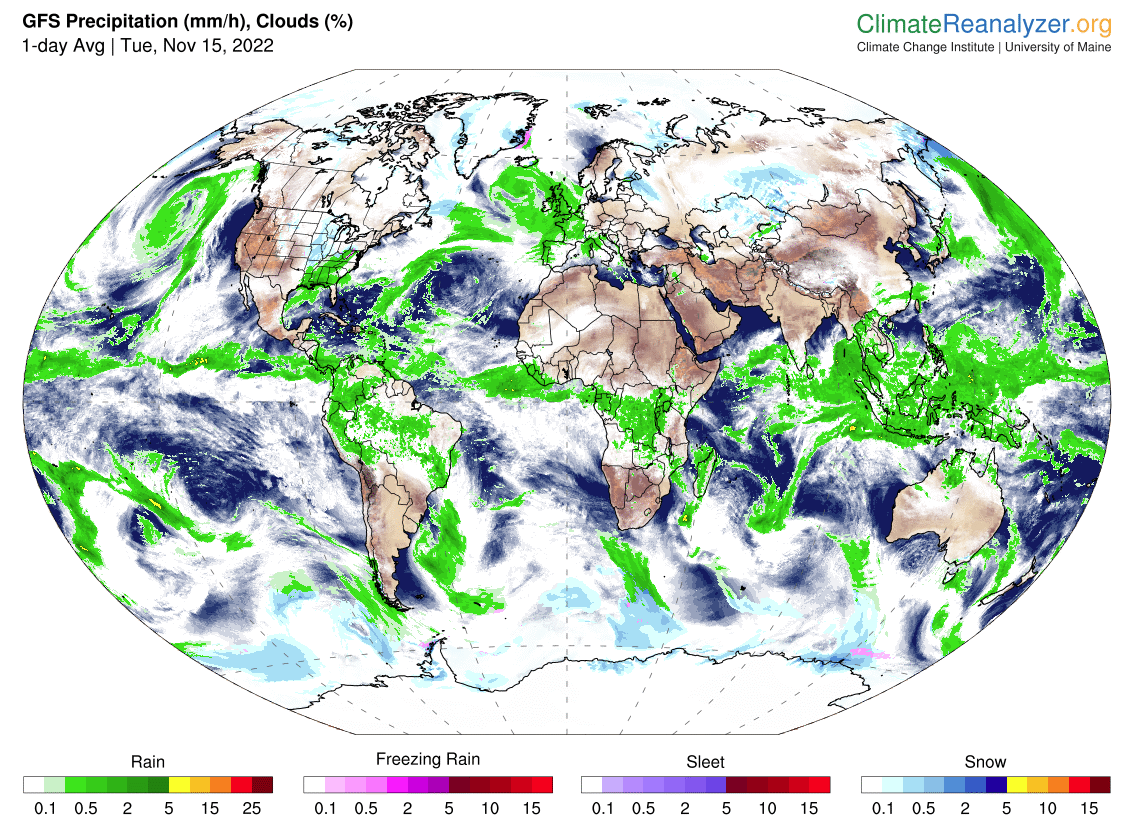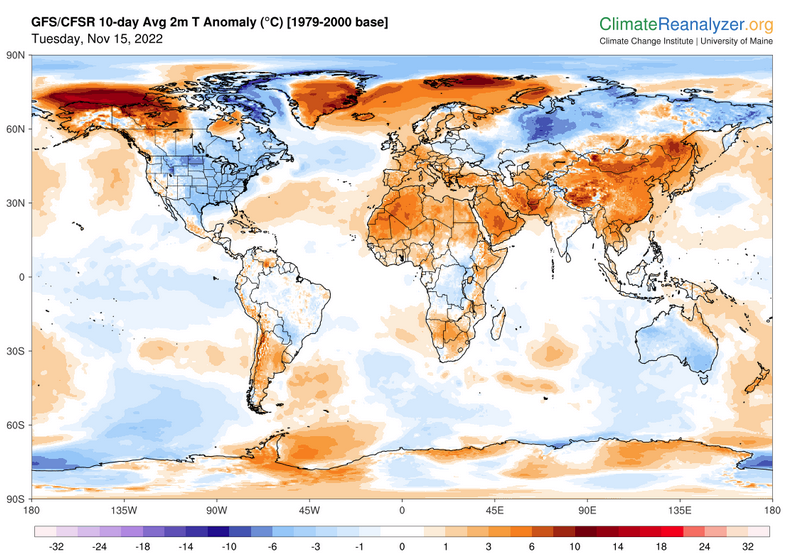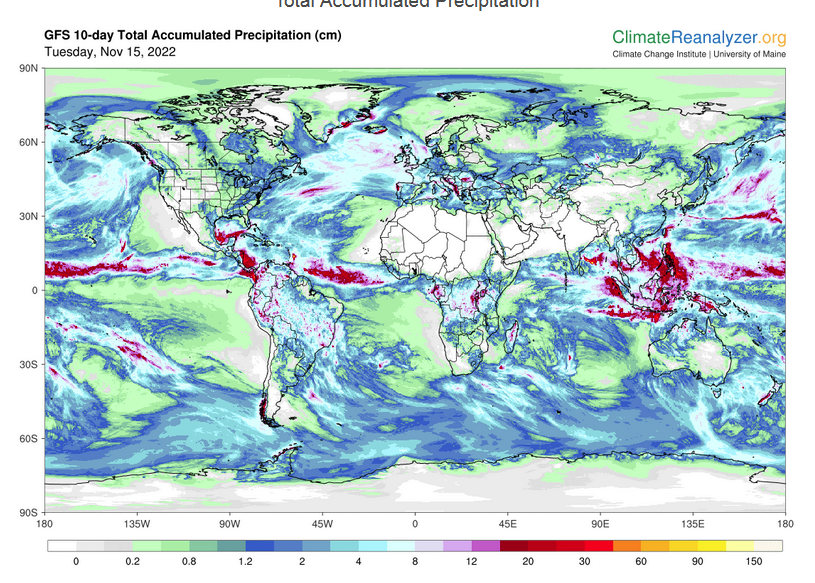Here is what we are paying attention to this morning and the next 48 hours from this morning’s NWS Forecast.
...Light snow accumulations across the mid-Missouri Valley and Midwest through Tuesday morning... ...Coastal rain; inland mixed precipitation on Tuesday evening into Wednesday across Northeast and Mid-Atlantic as coastal low develops and moves up coast... ...Anomalously cold air will continue to grip the lower 48 through the work week... ...Strong Santa Ana winds return across Southern California on Tuesday; High Wind Warnings in effect...
Continuation of the NWS Short Range Forecast (It is updated twice a day and these updates can be found here.
A deep upper-level trough swinging through the eastern U.S. will drive an active start to the work week as a developing storm system produces multiple weather hazards. Across eastern Kansas, the mid-Missouri Valley, and the southern Midwest, the first widespread light snowfall of the season is ongoing and expected to continue through Tuesday, with snow ending from west to east as a shortwave ejecting out of the Plains moves through the region. Winter Weather Advisories have been issued for much of the area, with a general 1-3" of snow possible through Tuesday. Further south, a low-pressure system developing along the Texas Gulf Coast is forecast to track along the coastline, producing rainfall across the Mississippi Valley and Southeast on Tuesday as moist air streams northward from the Gulf of Mexico. While precipitation is forecast to remain light to moderate, some locally heavier rainfall rates will be possible along the immediate coastline in the warm sector of the system, especially in the early Tuesday morning hours. As the upper-level energy progresses northeastward into the Mid-Atlantic late Tuesday, a coastal low will develop offshore the Carolinas before intensifying, and moving up the coast, producing widespread precipitation across the region. On Tuesday afternoon, areas of rain/freezing rain are expected to develop over parts of the Central Appalachians, with higher elevations receiving snow, before expanding northeastward into the Mid-Atlantic and Northeast as the system tracks up the coast. Interior portions of the Northeast and New England may receive accumulating snow Tuesday night before changing over to mixed precipitation and even rain during the early Wednesday morning hours, while higher elevations are forecast to remain snow for a longer time. However, uncertainty surrounding precipitation types is still high, as the track of the system and temperature profiles will dictate where the rain/snow line sets up and how long snow lasts. Regardless, widespread Winter Weather Advisories have been issued for the Appalachians, central Pennsylvania, and upstate New York through early Wednesday, as wintry precipitation may cause hazardous travel conditions. Moreover, in coastal sections of the Northeast and New England, up to an inch of rain is forecast to fall through Wednesday before the system exits into the Canadian Maritimes. Furthermore, anomalously cold air continues to grip the nation as high temperatures are forecast to remain 10-20 degrees below average through the work week. Locations as far south as the Gulf Coast will experience high temperatures dipping into the lower 50s and even the upper 40s on Wednesday and Thursday. On the backside of the upper-level trough swinging through the Plains, even colder air will filter in from Canada as highs struggle to get above freezing during the daytime hours this week across the central U.S. Lastly, high-pressure building into the Great Basin region will lead to strong Santa Ana winds across southern California beginning Tuesday evening due to an increasing pressure gradient across the region. As a result, High Wind Warnings have been issued for the Transverse Ranges until Wednesday night, where winds may gust as high as 75 mph.
Current forecast of heavy precipitation (Updates can be found HERE)
Maps that relate the forecast to geography can be found by clicking Here for Day 1 and Here for Day 2.
Here is a 60-hour animated forecast map that shows how the short-term forecast is expected to play out
If it needs to be updated click here.
ATMOSPHERIC RIVERS
Click HERE to update. Here is some useful information about Atmospheric Rivers.
HAZARDS OUTLOOKS
Click here for the latest complete Day 3 -7 Hazards forecast which updates only on weekdays. Once a week probably Monday or Tuesday I will update the images. I provided the link for readers to get daily updates on weekdays. Use your own judgment to decide if you need to update these images.
Worldwide Tropical Forecast
(This graphic updates on Tuesdays) If it has not been updated, you can get the update by clicking here This is a new approach and covers weeks 2 and 3 not weeks 1 and 2. It has more information but I am having trouble getting used to it. As usual, it comes with a discussion which is below
Detailed Maps and Reports for the Western Atlantic and the Pacific Oceans
Below are four maps that summarize the situation for the Atlantic, Eastern, Central Pacific, and Western Pacific. Additional information can be accessed by clicking HERE
First the Atlantic
Click to view the forecast map and have access to additional information https://www.nhc .noaa.gov/gtwo.php?basin= atlc&fdays=5
Then Eastern Pacific
Click to view the forecast map and have access to additional information https://www.nhc.noaa.gov/gtwo.php?basin=epac&fdays=5
Then Central Pacific
Click to view the forecast map and have access to additional information https://www.nhc.noaa.gov/gtwo.php?basin=cpac&fdays=5
And the Western Pacific
Click to view the forecast map and have access to additional information https://www.metoc.navy.mil/jtwc/jtwc.html
Some Intermediate-Term Outlooks
Links to “Outlook” maps and discussions for three time periods. Days 6 – 10, Days 8 – 14, and Weeks 3 and 4. An outlook differs from a forecast based on how NOAA uses these terms in that an “outlook” presents information from deviation from normal and the likelihood of these deviations.
You have to click on the links because they do not update automatically and I do not want to have stale images in the article. But it is not difficult to click on a link and you get a large image plus a discussion. On Fridays in a separate article, we will show the images and provide a link in this article that article. But remember what you will see is the images as of Friday. But here you can get the current images simply by clicking on them. Then hit the return arrow at the upper left of your screen to return to the article. You will not find this information easily anywhere else.
Right now you can find these maps here (We show them every Friday there but you can click above and find them).
Worldwide Weather
Below is the current or short-term precipitation forecast which can be updated by clicking HERE Additional maps can be obtained HERE.
Month to Date Information
Month to date Temperature can be found at https://hprcc.unl.edu/products/maps/acis/MonthTDeptUS.png
Month to date Precipitation can be found at https://hprcc.unl.edu/products/maps/acis/MonthPNormUS.png

